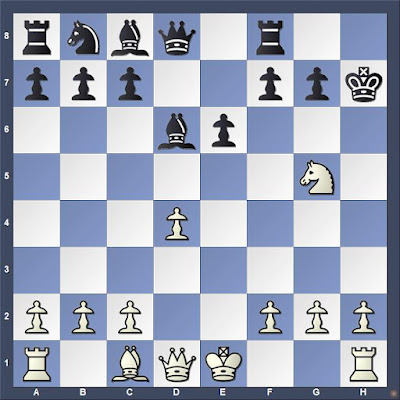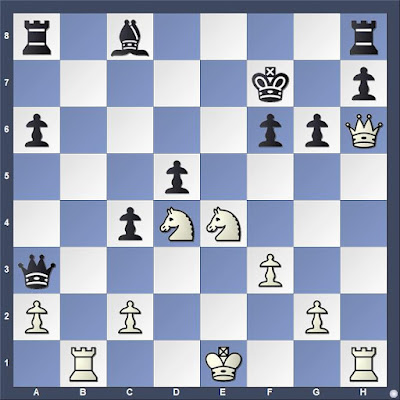The after school chess club that I run in an elementary school began the second week of October after a week's delay because I had COVID. We meet twice per week with some students coming both days and some coming once each week. Each session is devoted to children playing chess with other and sometimes with me. There is always a short lesson. As the year goes along, sometimes these lessons will be built around a worksheet. For example, the students will see as many worksheets from my
Essential Tactics* as time allows.
Chess Skills has a record of a great many of my lessons in years past. The tag, "
Problem of the Week" links to these.
Here is a synopsis of the lessons so far this fall for further review by students and parents, as well as for anyone interested.
11 October
We began with an endgame position that occurred in a game that I played online and that I believe highlights the importance of calculation and a single tempo in a pawn race. "
Time and Speed" shows this position with analysis of the game's conclusion and how White should have played.
13 October
Young students often express frustration when their opponent "copies" their moves. The lesson featured a game played by Jose R. Capablanca a few years before he became World Champion. In symmetrical positions, the first player often has an advantage. Check puts an end to the copying.
Capablanca,Jose Raul -- NN [C49]
New York casual New York, 1918
1.e4 e5 2.Nf3 Nc6 3.Nc3 Nf6 4.Bb5 Bb4
The copying begins.
5.0-0 0-0 6.d3 d6 7.Bg5 Bg4 8.Nd5 Nd4 White to move
9.Nxb4 Nxb5 10.Nd5 Nd4 11.Qd2 Black to move
11...Qd7??Now, Black is lost. After 11...Nxf3+, White is only slightly better.
12.Bxf6 Bxf3 13.Ne7+ Black to move
13...Kh8
13...Qxe7 is best. Black loses the queen. The move played gives White a forced checkmate in three. Students were asked to find the conclusion.
14.Bxg7+ Kxg7 15.Qg5+ Kh8 16.Qf6# 1-0
18 October
Students were presented with a difficult endgame position that was part of Hikaru Nakamura's analysis of Niemann,H. -- Lenderman,A., Saint Louis 2022, a game played the previous day in the US Championship.
White to move
I had no expectation that young players would find the correct move. However, the wrong answers are quite instructive for showing the difficulties a bishop has stopping three connected passed pawns. It is an impossible task in this case.
45.Bb5!! is the only winning move.
If Black captures the bishop, then White queens first and the queen controls Black's promotion square. 45...axb5 46.a6 h3 47.a7 h2 48.a8Q.
If Black opts to leave the bishop alone and advance pawns, play might continue 45...h3 46.Bxa6 g5 47.Bf1 g4 48.a6 h2 49.Bg2 f4 50.a7 f3 51.a8Q fxg2 52.Qxg2 and White wins.
Following this lesson, I showed the students the game's continuation beginning with White's move 30.
White to move
30.Kb4!Nakamura praised this move.
30...Nf4 31.Rh2 Kc7 32.a5 cxb5 33.Bxb5 a6 34.Ba4Nakamura stated that 34.Bc4 seems more natural, but also pointed out how Niemann's move keeps Black from occupying the open e-file with his rook.
34...Ne6 35.d5 Nxg5 36.d6+Black to move
It was here that Alex Lenderman made the error that cost him the game. This position was where we began Thursday's lesson.
20 October
The lesson was to understand the threats that Lenderman overlooked.
36...Kd8?Students suggested 36...Kb8, which is better than 36...Kd8. According to Nakamura and Stockfish, 36...Kc8 would have given Black excellent chances to hold a draw.
37.c6Niemann played the only winning move.
37...bxc6 38.Kc5Again, the only winning move.
38...f4Nakamura analyzed 38...Ne4+ and some of this analysis was shared with my students. One of these lines leads to the endgame position that was Tuesday's focus.
39.Rb2 Ne6+ 40.Kxc6Black to move
If Black's king were on c8, White would not have a checkmate threat. This threat forces concessions that lead to a position where Black must give up the rook for White's queen.
40...Nd6+ 41.Kd5 Nb5 42.Bxb5 axb5 43.Kc6 Ke8 44.Kc7Black to move
I pointed out to the students that if we removed all the pieces except the two kings and White's d-pawn, we would have an elementary pawn ending position that they all need to know.
44...Kf7 45.d7 1-0Lenderman resigned here. Young students, however, benefit from seeing the reason on the board.
45.d7 Ke7 46.Re2+ Kf7 47.d8Q Rxd8 48.Kxd8 and White's rook will be able to stop Black's two passed pawns. A student needed to see even this demonstrated, so I showed him a couple more moves until he said, "Okay, now I get it."
Next week, the demo board and/or worksheets will be used to teach some checkmate patterns or techniques.













































